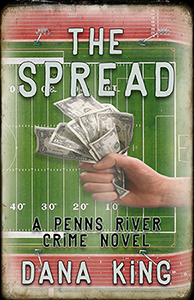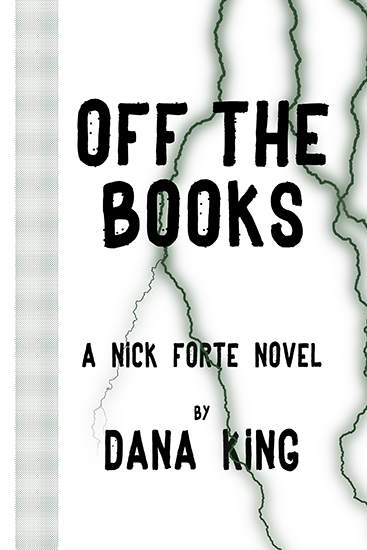Eryk Pruitt is
an impressive fellow. He’s rapidly gaining acclaim as a writer of both fiction
and non-fiction, does voice work for television and movies, and has won so much
cutlery at DC-area Noirs at the Bar that Ka-Bar calls him when they’re short of
inventory. I don’t spend a lot of time in the car, and I prefer to read things
rather than listen to them, but hearing Eryk had a true crime podcast piqued my
interest, especially after The Beloved Spouse™--a/k/a Eryk’s beloved Aunt Corky—heard
a couple of episodes and suggested I make some time for it.
Well, now.
It was not what
I expected at all. I ran some sections through again to make sure I heard that
right. Eryk and Drew Adamek hit the right tone and the right medium; The Long Dance wouldn’t have been as good as either a documentary or a
true crime book. I thought of writing a review but knew I didn’t have the chops
to express what I thought of it, not knowing enough about the inner workings of
podcasts, so I got Eryk to sit for an interview.
One Bite at a Time: Let me start with how impressed and
moved I was by The Long Dance. I kept
jotting down questions and I can’t decide which to ask first. When in doubt
it’s always good to start at the beginning, so I’ll try that. You’re a Texas
native—Dallas area, I think—now living in Durham, NC. When did you leave Texas
and what was about Durham that got you to settle there?
Eryk Pruitt: After college, I moved around a bit
(New Orleans, Ireland, etc) and discovered that not everybody in the world
suffered Texas summers, so I found myself a bit spoiled. I moved to North
Carolina in 2007 where I’ve since enjoyed four seasons per year and I don’t
think I could handle anything else. I love the American South, and we
discovered Durham by happy accident. It’s close enough to New York City, DC,
and Atlanta that I can drive there if I’m needed, but far enough away that I don’t
have to deal with any of their riff-raff.
OBAAT: How did you hear about the Mann/McBane murders? You
weren’t in the Durham area when they took place—hell, you weren’t born yet—and you’re not native to the
area. What brought this case to your attention and what drew you in to spend so
much time and energy on it?
EP: We bought a house smack dab between the landmarks of that
case. I can’t drive to town without passing where Pat and Jesse were abducted,
nor can I go to the grocery store without passing by where their bodies were
found. We’re out in the woods, so more “town” than Duke’s “gown,” and everyone
can still remember this ghost story from their childhood. It’s almost become
urban legend, because it faded so far into obscurity. But still, everybody had
questions. I could hardly believe that something so tragic had happened and
then disappeared from the collective consciousness with no answers. In the
beginning, that was the question I wanted to answer: why was no one talking
about it? It developed into much, much more.
OBAAT: You have a lot of irons in the fire and are constantly on
the move. How long did it take to put The
Long Dance together and how did you find the time?
EP: Two years and counting. Due to recent developments in the
case as a result of our podcast, we are still working on it. But the initial
eight episodes took two years to research, write, and produce. I did all this
in my spare time because I was also writing a novel (What We Reckon), producing a short film (Going Down Slow), and managing a bar.
OBAAT: What were some of the logistics involved in getting the
interviews? Things like setting them up, locations, getting there, how the
recordings were done. Stuff like that.
EP: The hardest part was getting people to trust us enough to
open up to us. It took six months to convince Captain Tim Horne of the Orange
County Sheriff’s Office that we were serious about the case. Then we needed to
talk to the family members and friends of Pat and Jesse. Each interview subject
needed their own reassurances, but once we got there, the process took off. I
never knew what to expect. No matter how much research I did, we always learned
something new. We recorded off a Zoom recorder with a shotgun microphone. I
would man the equipment and take notes while Drew Adamek would interview the
subject. Once it was finished, I would transcribe the interviews and file those
away for construction of the episodes.
OBAAT: Not to minimize the horrific nature of the murders, but
what struck me most about The Long Dance
was the lack of communication and coordination between the police departments.
It was almost as if some of them didn’t want to see the case solved if they
weren’t going to be the ones who solved it. What are your thoughts on that, and
what was your biggest takeaway from spending so much time immersed in the
project?
EP: It's very hard to measure law enforcement standards of
1971 against the standards of today. It's difficult to remember that communication
was not as easy back then as it is today. I was told one story by Major Horne
about Chapel Hill's "Coke bottle dispatch" system. Since CHPD didn't
have radios yet, they would require all units to drive past the station every
30 minutes and if the window was propped open by a Coca Cola bottle, the
responder was required to run inside the station and find out where they needed
to go. That was in the late sixties. These days, as you can imagine, it's
completely different. While I'd be on a ride with Horne, he'd field texts and
phone calls from agencies across the state. A homicide investigator in Durham
would ask him a question about a suspect who lived in Horne's jurisdiction, or
a detective in Onslow County might need some further information about a case
out there. Back in 1971, yes, there were a lot of communication and competition
issues. Horne was the first to combine all the information from the six (six!) different LEOs who investigated
the case, and only then did a complete answer present itself. Unfortunately,
that was forty years after the murders. These days, I strongly believe the
killer would have been caught much quicker. But like (former journalist)
Cornelia Olive said in Episode Two: in 1971, everyone wanted to be the one to
solve it, so they kept a lot of information to themselves. It would never have
happened today.
OBAAT: I’ve read your stuff and heard you read at Noirs at the
Bar. You’re the goods. What led you to decide to create The Long Dance as a podcast instead of writing a non-fiction book?
This in no way disparages the podcast—more on that later—but I’m a printed word
guy and I’m curious.
EP: After our first interviews with the friends and families
of Pat and Jesse, I knew that I would never possess the vocabulary to articulate
the pain and heartbreak I heard in their voices when they spoke of the tragedy
that befell them in 1971. The fear when the nurses knew that one of their own
was missing and they wondered if they might be next. How many times would I be
able to describe a person breaking down into tears at a forty-seven year old
memory? I am not the smartest man in the world, but I’m smart enough to
delegate when a task gets to be too Sisyphean, like this one was. I decided to
let the voices do the heavy lifting.
Lucky for me, I
had Serial to lean on. The
twelve-part investigative series from This American Life was a huge influence
on me. I’d be hard pressed to think of a greater storytelling feat in our
century. I always wanted to tackle something with the depth and narrative power
that Serial had, but never thought
I’d find a story worthy of it. Then along came the North Carolina Valentine’s
Murders of 1971…
OBAAT: As I mentioned above, I’m a printed word guy. I’d almost
always rather read transcripts of interviews because…well, because I’m busy and
I read faster than I listen and can skip over things that don’t interest me.
That said, The Long Dance had me
riveted from early in the first episode. Your voice and skill as narrator was
compelling and using clips from the actual interviews demanded my full
attention in ways I hadn’t expected. What were some of the considerations that
went into the editing and pacing?
EP: I knew Drew Adamek had to lead. He had a journalism
background and no accent, so it’d be best to have him do most of the intro. We
could lean on my Southern drawl for history and “color commenting.” It was my
opinion that too much Southern would make it difficult for the LA and NYC types
to comprehend. (I was shocked to find that my voice is what’s earned me the
most money from the project, as I’ve gone on to be hired to narrate a
documentary—Trouble Will Cause by
Wreak Havoc Productions—and a voice role in an NBC sitcom, Trial & Error, as well as other roles.) We structured the
episodes into eight subjects and we followed the typical rising and falling
action arc, and tried to let each episode unfold, then wrap up into a
cliffhanger at the end. We were lucky to have Piper Kessler of Velasquez
Digital Media edit our sound and make us sound pretty, as well as Michael
Rollin who developed our creepy score.
OBAAT: Have you heard from Dr. Britt since the podcast came out?
For that matter, have you received feedback from any of the principals who
listened to it?
EP: I have not heard from The Good Doctor. He does not return
any of my letters or phone calls. I am anxious to hear what he thinks.
However, I
remain close with some of the family members, who have given me a seal of
approval. That was very, very important to me because a large part of what I
wanted to do was tell the story of Pat and Jesse, because they cannot speak for
themselves. What happened to them was so horrible and, behind all the
sensationalist trappings that true crime offers the audience, I wanted that to
remain at the forefront.
I teased it
earlier, but there have been new developments, which could result in more than
a follow-up episode, but hopefully an arrest. That would be the greatest
success that anyone could possibly ask for.
Also, other
people have reached out to me about cold cases in the Carolinas. I am anxious
to discover where any of this might lead The
Long Dance!
* * *
Hopefully this
interview leads you to The Long Dance.
It’s available at all the better podcast services and at its own site here. You won’t be sorry and it will
haunt you, maybe forever.





